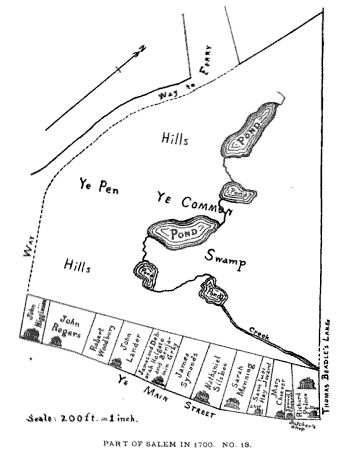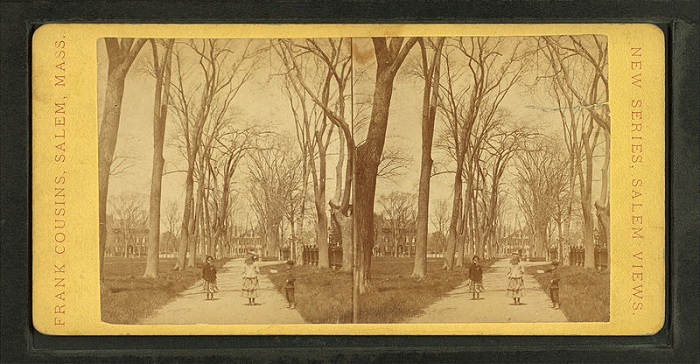Salem Common is a historic city park in Salem, Massachusetts.
The park was once a hilly, swampy area about nine acres in size that was home to five ponds and a creek. The colonists used the common as grazing land for their livestock and as training grounds for the local militia as early as 1637.
As a result, the colonists often referred to the common as the pen, the town swamp or the common lands.
The five ponds were named Flag pond, Southwick pond, Mason’s pond, Cheaver’s pond and Lang’s pond. A creek connected each of the ponds and extended to the southeast corner of the common where it flowed along Washington Square East and then turned and ran down what is now Forrester Street before emptying into Collins Cove.
In 1714, the common was designated a training field for military drills by the Salem militia.

In 1770, an almshouse was built on the common, which opened to the public in 1772. It remained in operation until a new almshouse was built on Salem neck in 1816.
In 1801, Elias Hasket Derby Jr was appointed the colonel of the Salem militia and raised $2,500 to improve the common.
As a result, the city turned the old town swamp into a park by leveling the land, filling in the creek and ponds, planting poplar trees and shrubs, laying out the walkways and constructing a wooden fence around the park with four ornamental gates.
The western gate was designed by local architect Samuel McIntire and featured a carved wooden medallion portrait of George Washington.
In 1817, the poplar trees on the common were replaced with elm trees and the deteriorated wooden fence was replaced with a new fence made of oak.
In 1818, when workers were digging a foundation for the Andrew House on the west side of the common they found the remains of a blacksmith shop, complete with a forge. It’s not clear when the shop existed but it is possible it was built as early as the 18th century, according to the diary of Salem Pastor William Bentley.
In 1850, the wooden fence and gates surrounding the park were replaced by a cast iron fence.

In 1926, the Salem Common Bandstand was constructed as a part of the Salem Tercentenary celebrations.
In 1928, the Salem Park Department took over management of the park.
The Salem Common Playground was constructed in 1970.
On July 4, 1976, a replica of the original western gate designed by McIntire was constructed. On the north side of the arch is a carved image of George Washington. On the south side of the arch is a carved image of a Native-American on a shield.
In 1976, Salem Common was added to the National Register of Historic Places.
Sources:
Perley, Sidney. “Part of Salem in 1700. No. 4.” The Essex Antiquarian: A Monthly Magazine Devoted to the Biography, Genealogy, History and Antiquities of Essex County, Massachusetts. Vol III, 1899, pp: 97-102.
Osgood, Charles and H.M. Batchelder. Historical Sketch of Salem, 1626 – 1879.Boston: Wright and Potter Printing Company, 1879.
Dow, George Francis. The Records of the Salem Commoners, 1713-1739. Essex Institute, 1908.
Dowgin, Christopher Jon Luke. “Commons.” Salem Secret Underground: The History of the Tunnels in the City. Salem House Press, 2017.
Bentley, William and Joseph Gilbert Walters and Marguerite Dalrymple. The Diary of William Bentley D.D. Pastor of the East Church, Salem, Massachusetts, Vol. 4., January, 1811 – December, 1819. Essex Institute, 1914.
Stella, Jeanne. Historic Streets of Salem, Massachusetts. History Press, 2020.
“A Living Shoreline: Collins Cove.” MapJournal, sscw.maps.arcgis.com/apps/MapJournal/index.html?appid=496d9bad740341de801197303a5eaa66
“Salem Common.” MACRIS, Massachusetts Cultural Resource Information System, Massachusetts Historical Commission, mhc-macris.net/Details.aspx?MhcId=SAL.930
